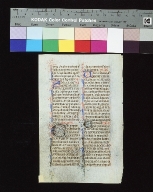|
REFINE
Browse All : Breviaries - Illustrations
1-3 of 3
Title
Breviarium: fragment
Creator
Catholic Church
Summary
[Ms. This manuscript leaf is part of a collection of medieval manuscript leaves selected to illustrate the art of the manuscript during the period of its greatest development and influence. They have been taken from books written in various European scriptoria by Benedictine, Franciscan, Carthusian, Dominican, and other orders of monks. Many are enriched with handsome borders, initial letters, and line-endings rendered in color. Twenty-five are illuminated with burnished gold or silver. The texts include the Bible, various church service books, the writings of the Church fathers, and some of the Classics., In script, Breviaries were seldom owned by laymen. They were service books and contained the Psalter with the versicles, responses, collects and lections for Sundays, weekdays, and saints' days. Other texts could be included. A Breviary, therefore, was lengthy and usually bulky in format. Miniature copies like the one represented by this leaf are rare. The angular gothic script required a skilled calligrapher. It would be difficult for a modern engrosser to match, even with steel pens, the exactness and sharpness of these letters formed with a quill by a 13th century scribe. Green was a decorative color added to the palette in the late 13th century in many scriptoria. The medieval formulae for making it from earth, flowers, berries, and metals are often elaborate and strange. This manuscript was written on fine uterine vellum, i.e., the skin of an unborn calf. It evidently had hard use, or may have been buried with its owner. This vellum leaf was created in France.]
Title
Breviarium: fragment
Creator
Catholic Church
Summary
[Ms. This manuscript leaf is part of a collection of medieval manuscript leaves selected to illustrate the art of the manuscript during the period of its greatest development and influence. They have been taken from books written in various European scriptoria by Benedictine, Franciscan, Carthusian, Dominican, and other orders of monks. Many are enriched with handsome borders, initial letters, and line-endings rendered in color. Twenty-five are illuminated with burnished gold or silver. The texts include the Bible, various church service books, the writings of the Church fathers, and some of the Classics., In angular gothic script, The Breviary is one of the six official books used by the Roman Catholic Church in its liturgy. It is a book of prayer for the clergy, giving the directions for all of the various services of the Divine Hours throughout the year. The other five official books are the Pontifical, the Missal, the Ritual, the Martyrology, and the Ceremonial of the Bishops. The angular script in this leaf is executed with great skill and precision. The small and vigorous black initials and the hair line details found in many of the ascenders and terminal letters indicate the work of a superior calligrapher, skilled not only in writing but also in sharpening his quill. The initials and the dorsal decorations also represent the same high standard of craftsmanship. Strangely, the rubrications do not show as great a calligraphic skill. Usually it was the task of a superior scribe to insert the rubrics or directions for conducting the service. This vellum leaf was created in France.]
Title
Breviarium: fragment
Creator
Catholic Church
Summary
[Ms. This manuscript leaf is part of a collection of medieval manuscript leaves selected to illustrate the art of the manuscript during the period of its greatest development and influence. They have been taken from books written in various European scriptoria by Benedictine, Franciscan, Carthusian, Dominican, and other orders of monks. Many are enriched with handsome borders, initial letters, and line-endings rendered in color. Twenty-five are illuminated with burnished gold or silver. The texts include the Bible, various church service books, the writings of the Church fathers, and some of the Classics., In angular gothic script, In the middle of the 14th century many of the manuscripts show influences from other countries. Illuminators, scribes, and other craftsmen traveled from city to city and even from country to country. While the script of this leaf is almost certainly French, the initial letters and filigree decoration might easily be of Italian workmanship, and the greenish tone of the ink suggests English manufacture. The dorsal motif in the bar ornament is again decidedly French, and the lemon tone of the gold is a third indication of French origin. In England, the burnished gold elements are generally of an orange tint, due to the presence of an alloy; in Italy, they are a rosy color because the underlying gesso or plaster base was mixed with a red pigment. This vellum leaf was created in France.]
1-3 of 3
|


